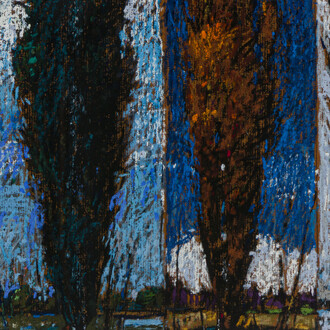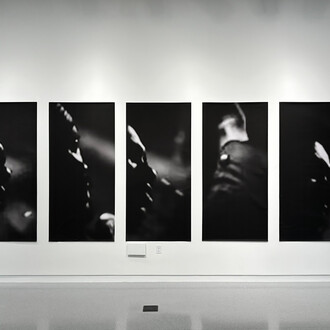In Ovid’s Metamorphoses, Philomela finds herself held captive in a rural site, her tongue severed by her abuser. Voiceless, she embroiders scenes of her plight on tapestries. These embroideries might be one of the first predecessors to documentary photography. Using photography and embroidery as recording tools, Fia Backström’s The great society explores how communities take shape and survive in the face of converging environmental and extractive crises. The exhibition is based on extensive field research in West Virginia, where the artist began traveling and meeting with locals in 2017. Backström responds to the area’s photographic history, government hearings, and community embroidery practices through her own material and computational processes that include photography, videos, language, and textiles.
The great society takes its title from a 1960s social policy aimed at combating poverty and racial injustice, championed by the same U.S. president who stated: “if you can convince the lowest white man he's better than the best colored man, he won't notice you're picking his pocket.” Statements like these perpetuate the conflicts between race and class that persist to this day, with comments such as “baskets of deplorables,” only deepening barriers to solidarity. For Backström, West Virginia functions much like a repressed unconscious, a zone of extraction onto which projections of "backwardness" and "trash" abound. A central touchstone for the work is the Buffalo Creek mining disaster of 1972, when a coal slurry dam collapsed and killed hundreds, left thousands homeless, and the land toxic. The mining company blamed "God’s hand," while the community became the subject of psychiatric studies on collective trauma. Up the mountain from Buffalo Creek is Blair Mountain, where in 1921, miners marched in the largest labor uprising in American history. Beyond their heavily surveilled exteriors, the mines’ cavernous spaces of fossilized darkness conjure possibilities for resisting, concealing, and creative healing.
Backström’s experiments with language and image are both indexical and speculative. In a fragmented form of visual docu-poetry, the artist addresses the complex relationship between photography and trauma. Days without lost time accident, a photographic series of signs outside the mines in Buffalo Creek, shows how injured workers are quantified against efficiency. The exhibition’s large-scale display mechanism, Sacrifice zone, recalls the infrastructure of the West Virginia industrial landscape and pushes the limits of visibility with a constellation of layered, hand manipulated prints on transparent film. Backström also invited members of the Buffalo Creek community to participate in an embroidery circle as an act of bearing witness. In search of a photographic ethic, she weaves together testimonies of folk medicine practitioners, scholars on faith and dam regulation, strip mining activists, and the spirits of the mountains.
Fia Backström: The great society is organized by Lindsey Berfond, Assistant Curator and Studio Program Manager with Hitomi Iwasaki, Director of Exhibitions and Head Curator.












